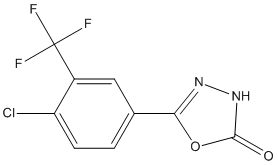SCHEMBL21776992
Inhibitor of Notum derived from compound 26 Lead series 1. IC50 0.0018 microM IC50 18 +/- 3 nM
General
Type : Trifluoro,Oxadiazolone,Oxadiazol
Chemical_Nomenclature : 5-[4-chloro-3-(trifluoromethyl)phenyl]-3H-1,3,4-oxadiazol-2-one
Canonical SMILES : C1=CC(=C(C=C1C2=NNC(=O)O2)C(F)(F)F)Cl
InChI : InChI=1S\/C9H4ClF3N2O2\/c10-6-2-1-4(3-5(6)9(11,12)13)7-14-15-8(16)17-7\/h1-3H,(H,15,16)
InChIKey : SBBOPUCCCOEMDA-UHFFFAOYSA-N
Other name(s) : 5-(4-Chloro-3-(trifluoromethyl)phenyl)-1,3,4-oxadiazol-2(3H)-one,ARUK3000263,Compound23dd,Compound 7a,7a,QR2
MW : 264.59
Formula : C9H4ClF3N2O2
CAS_number :
PubChem : 146425072
UniChem : SBBOPUCCCOEMDA-UHFFFAOYSA-N
IUPHAR :
Wikipedia :

Target
Families : SCHEMBL21776992 ligand of proteins in family: Pectinacetylesterase-Notum
Stucture : 6ZVL Structure of the human Wnt deacylase Notum in complex with SCHEMBL21776992 (ARUK3000263 Compound23dd 7a)
Protein : human-NOTUM
References (2)
| Title : Structural Analysis and Development of Notum Fragment Screening Hits - Zhao_2022_ACS.Chem.Neurosci_13_2060 |
| Author(s) : Zhao Y , Mahy W , Willis NJ , Woodward HL , Steadman D , Bayle ED , Atkinson BN , Sipthorp J , Vecchia L , Ruza RR , Harlos K , Jeganathan F , Constantinou S , Costa A , Kjaer S , Bictash M , Salinas PC , Whiting P , Vincent JP , Fish PV , Jones EY |
| Ref : ACS Chem Neurosci , 13 :2060 , 2022 |
| Abstract : Zhao_2022_ACS.Chem.Neurosci_13_2060 |
| ESTHER : Zhao_2022_ACS.Chem.Neurosci_13_2060 |
| PubMedSearch : Zhao_2022_ACS.Chem.Neurosci_13_2060 |
| PubMedID: 35731924 |
| Gene_locus related to this paper: human-NOTUM |
| Title : 5-Phenyl-1,3,4-oxadiazol-2(3H)-ones Are Potent Inhibitors of Notum Carboxylesterase Activity Identified by the Optimization of a Crystallographic Fragment Screening Hit - Mahy_2020_J.Med.Chem_63_12942 |
| Author(s) : Mahy W , Willis NJ , Zhao Y , Woodward HL , Svensson F , Sipthorp J , Vecchia L , Ruza RR , Hillier J , Kjr S , Frew S , Monaghan A , Bictash M , Salinas PC , Whiting P , Vincent JP , Jones EY , Fish PV |
| Ref : Journal of Medicinal Chemistry , 63 :12942 , 2020 |
| Abstract : Mahy_2020_J.Med.Chem_63_12942 |
| ESTHER : Mahy_2020_J.Med.Chem_63_12942 |
| PubMedSearch : Mahy_2020_J.Med.Chem_63_12942 |
| PubMedID: 33124429 |
| Gene_locus related to this paper: human-NOTUM |